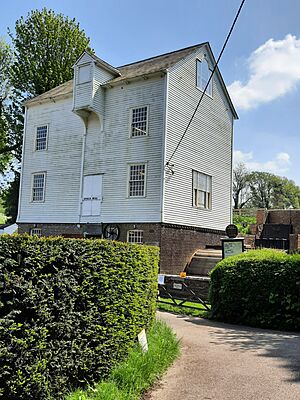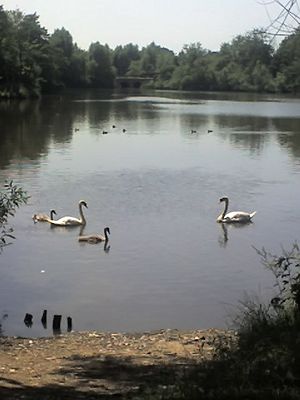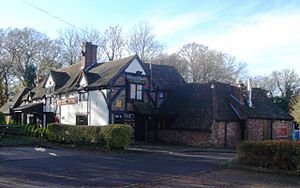Ifield Water Mill facts for kids
Quick facts for kids Ifield Water Mill |
|
|---|---|

The mill from the northeast, May 2023
|
|
| Location | Hyde Drive, Ifield West, Crawley, West Sussex RH11 0PL, United Kingdom |
| Built | 1817 (present building) |
| Built for | Thomas Durrant |
| Architectural style(s) | Weatherboarded Vernacular |
|
Listed Building – Grade II
|
|
| Official name: Ifield Water Mill | |
| Designated | 21 June 1948 |
| Reference no. | 1207630 |
| Lua error in Module:Location_map at line 420: attempt to index field 'wikibase' (a nil value). | |
The Ifield Water Mill is an old watermill located in the Ifield area of Crawley, a town in West Sussex, England. It was built in the 1800s. This mill stands where an even older, smaller flour mill once was. Before that, an iron forge (a place where metal is heated and shaped) operated here. The mill stopped being used in the 1930s.
In the 1970s, the local council bought the land for new homes. They then let a group of local people, who loved history, fix up the mill. They made it work again! Today, the mill and a house next to it are "listed buildings." This means they are important historical sites protected by law. There is also a cottage on the site, but it is not listed.
Contents
The Mill's Long History
The area around Ifield was once covered in thick forests. Small streams and parts of the River Mole flow through the land here. By the 1200s, at least one mill was already in the village. We don't know who owned it, but old tax papers mention it. It might have belonged to the local lord.
From Iron Forge to Flour Mill
By the late 1500s, an iron forge was on this very spot. The local lord owned the part of Ifield Brook that flowed from a furnace (a large oven for melting metal) nearby. In the 1500s, the brook was blocked to create a mill pond. This pond provided power for the forge. By 1606, there was a house, a barn, the mill, and the mill pond. A wealthy family called the Middletons, who owned many ironworks, rented the forge and its buildings.
The iron industry in Sussex quickly became less important in the mid-1600s. The nearby furnace closed in 1642 because all the trees had been cut down for fuel. The next year, during the English Civil War, soldiers destroyed what was left of the iron industry. The site of the Ifield forge was cleared. A corn mill (for grinding grain into flour) was built in its place. It was definitely working by 1660. A local Quaker, William Garton, ran it. He was often put in prison for his religious beliefs.
Growing and Changing Over Time
At first, the mill was small. But as milling became better, it grew. It was rebuilt in 1683. The Middleton family now owned the mill. Later, in 1715, a rich businessman named Leonard Gale bought it. For 50 years after 1759, different groups of people owned the mill.
By this time, it was the biggest corn mill in the area. When Napoleon threatened to invade the United Kingdom, a survey checked how much flour mills could make. Ifield Mill could make 16 sacks of flour and 120 loaves of bread every day! Other local mills could only make about four sacks a day.
Even though it was very good at its job, the mill stopped being used in the 1810s. A businessman from London bought it in 1809. It sat empty for eight years. Then, in 1817, Thomas Durrant, a miller from a nearby town, bought it for £1,200. He was the first owner who also worked as the miller. Under his care, the mill was completely rebuilt.
Rebuilding the Mill
The old building from 1683 was taken down. The mill you see today was built in its place. A special stone tablet from the 1683 building, with the date and the initials of the old owners, was saved and put on the outside of the new mill.
Thomas Durrant spent £3,500 on building the new mill. This money came from a lawsuit he won against miners who had damaged the water supply to his other mill. Soon, a similar problem started at Ifield. The water flow became weaker. In 1848, the mill pond was cut in half when the railway line to Horsham was built. This railway first crossed on a bridge, but soon an earth bank replaced it.
Also, in 1837, a competing windmill was built nearby. The mill slowly became less important. It passed through many owners. Even a family of millers who owned it for a long time struggled. A steam engine was added, but it often had to be run by hand because there wasn't enough water power. By 1927, the mill was no longer used. It was put up for sale in 1934. The advertisement called it "a gentleman's residence with a picturesque disused water mill," showing it was no longer important for milling.
Bringing the Mill Back to Life
The mill sat empty, mostly used for storage, until 1974. That year, Crawley Borough Council bought it. The council was buying land for new homes. They let a group of volunteers try to fix the mill, which was in very bad shape. Work began on June 15, 1974.
The Restoration Process
Every part of the mill was damaged from being unused for so long. Trees had grown into the building, pushing the roof apart. The main wooden beams holding the building up were rotting. A wall had fallen inwards. The water wheel was stuck in the mud.
The work took eight years, much longer than the three years they first thought it would take. But large donations helped pay for many new parts inside. Three staircases, the inner wall coverings, and the wooden floors were all replaced. All the windows were put back to their original design. Outside, the old wooden siding was removed, and a waterproof layer was put on. Much of the wood had to be replaced, but it still looked like the original. The roof was also fixed to stop it from decaying.
Replacing the main wooden supports was very hard. The whole building had to be lifted up with special jacks and held in the air while new wood was put in. Fixing the water wheel and its brick structure also took several years. Parts of the old wheel were saved and used in the new oak and steel wheel. The walls supporting it were completely rebuilt. A sluice gate (a control gate for water) was built across the mill pond. A water flow control system was brought from another old mill. The water wheel is an "overshot" type, meaning water flows over the top of it. It's the biggest overshot wheel in Sussex! It weighs about 6 tons, is 11 feet (about 3.3 meters) across, and can turn 8 to 15 times per minute.
Volunteers Make a Difference
Even though the work was huge and difficult, volunteers did almost all of it. They mostly worked on weekends. Some unemployed people helped for a short time, but no professional engineers or builders were hired during the eight years. The wooden parts of the waterwheel eventually rotted after about 30 years. So, with help from the Lottery Heritage Fund, a new steel waterwheel was built.
Efforts have also been made to improve the mill pond and the area around it for wildlife. The northern part of the pond was drained in 1976 during the work, and trees started to grow there. The part south of the railway was like a "desert" for animals. But by 1979, over 30,000 fish had been put back in the pond. Birds quickly returned too; a study found 58 different kinds of birds. The soil is good, which helps plants grow well.
How the Mill Looks
Ifield Water Mill is a tall building with three floors. The outside is covered in wooden siding. The bottom floor is made of brick, and the two upper floors are made of wood. The roof is made of slate and sticks out over the walls. The mill hoist (a device for lifting things), which was very rusty during the restoration, sticks out from the north side of the building.
What's Happening at the Mill Today
Ifield Water Mill was made a Grade II listed building by English Heritage on June 21, 1948. It is one of many important historical buildings in Crawley. The Borough Council still owns the mill, but it is rented to the Crawley Museum Society. Before the main Crawley Museum opened, a temporary museum was set up in the mill.
The mill house and a cottage were also bought by the council. They have been rented to people ever since. The mill house is a very old building from the 1500s. It used to be a half-timbered house, but it has been changed over the years. It is now a public house (a pub). It has an original tiled roof. This house was also made a Grade II listed building on May 1, 1974. The cottage is not listed. It was built in the 1500s or 1600s as a barn, but it was changed into a home in the 1930s.
An artist named Denys Ovenden painted a picture of the water mill in 2015. It shows what the mill looked like in 1848, with a steam train crossing the millpond on a wooden bridge. This painting was later used on a special Royal Mail postage stamp!





